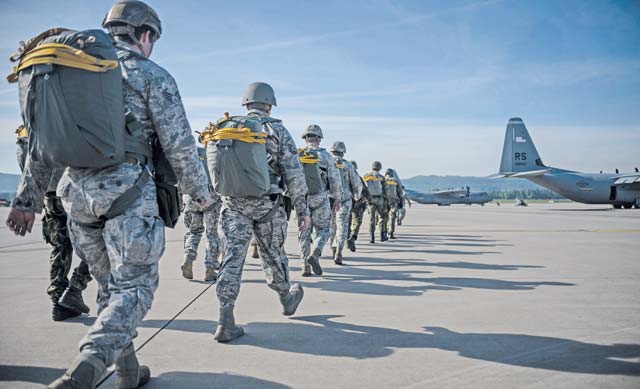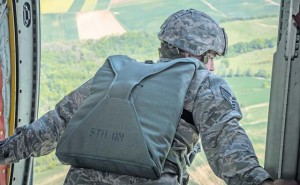
Parachutists from the U.S. and eight visiting nations came together to celebrate International Jump Week by participating in several jump-related training scenarios May 4 to 9 on Ramstein.
Approximately 300 jumpers with various backgrounds added their experience and training together to complete more than 500 static-line and high-altitude jumps.
The jumpers came from the Czech Republic, Estonia, Germany, Greece, the Netherlands, Romania, Spain and the United Kingdom.
“Jump week is all about building partnership capacities,” said Tech. Sgt. Brian Angell, 435th Contingency Response Group personal parachute program manager. “Many of the junior enlisted Airmen and Soldiers here today are getting their first chance to jump with international paratroopers, and the experience gained sharing training tactics and procedures is invaluable.”

Airmen and Soldiers weren’t the only ones sharing jumps for the first time with international service members. Many airborne troops from visiting countries also flew into the same first-time situation.
“It is always very important to familiarize yourself with partner nation procedures,” said Hellenic air force Capt. Byron Alivizatos, Search and Rescue Operations Squadron. “These jumps create an opportunity to form well-rounded paratroopers and strengthen deployed operations.”
The International Jump Week events also provided participants the opportunity to work across three different aircraft platforms, including the C-130J Super Hercules, the MC-130H Talon and a C-17 Globemaster II.
“Being a piece of this experience was incredibly satisfying,” said U.S. Army Pfc. Kelly Orullian, 5th Quartermaster Aerial Delivery parachute rigger. “A large part of what I do is making sure everyone is prepared and confident for their jump. What made this instance special was the chance to work with so many different jumpers from different nations.”
Working to create international bonds and friendships was a large part of International Jump Week. Harmonizing a large number of jumpers from eight different nations with different procedures and experiences was just as important as the actual jumping.
“As a jumpmaster you are responsible for the lives of the paratroopers inside the aircraft, and that’s something I take to heart,” said U.S. Army Staff Sgt. Alexander Munoz-Lamos, Special Operations Command Africa air NCO. “It’s a great opportunity to link up with our partner nations to improve our relationships within the airborne community. When you’re in there you control the aircraft. It doesn’t matter what rank they are. It doesn’t matter what rank I am.”


